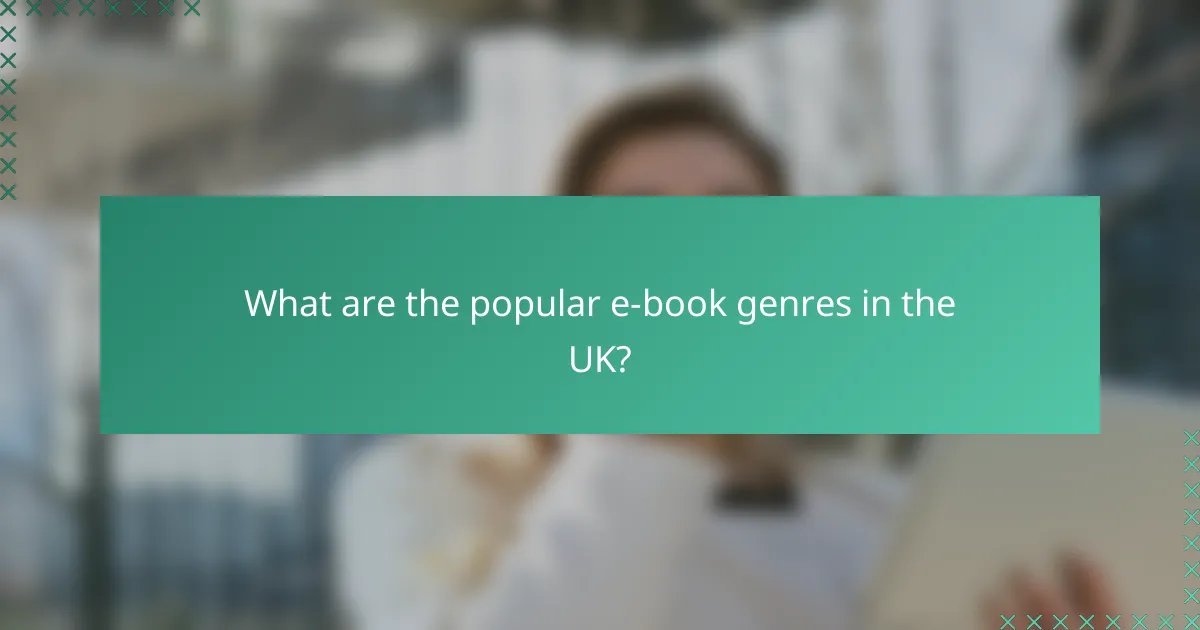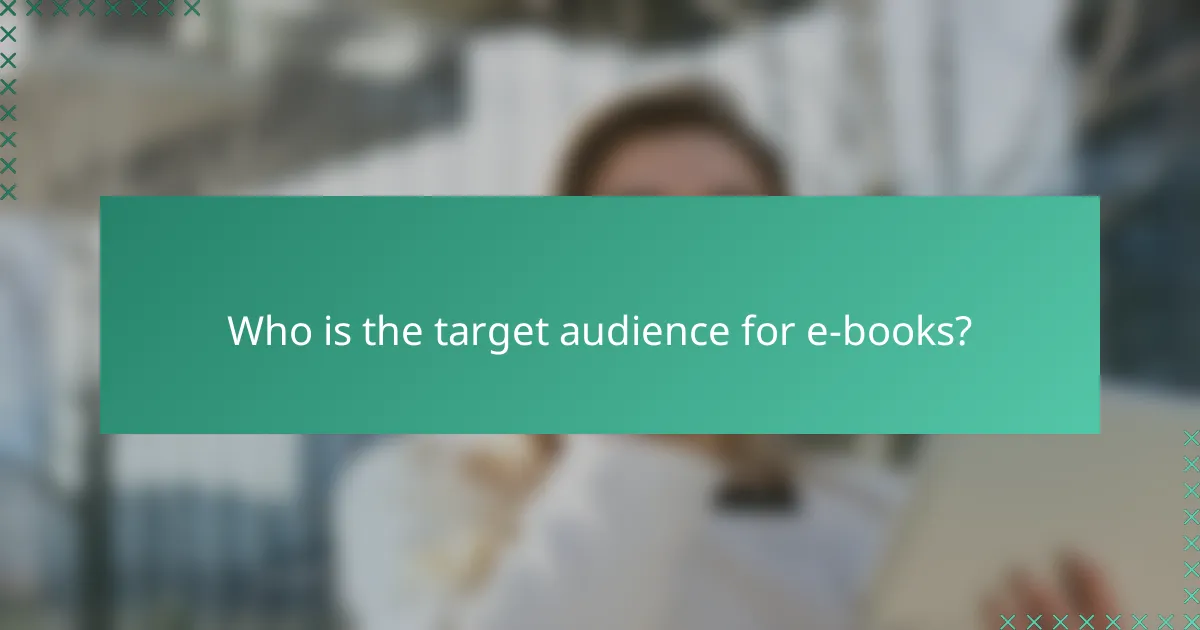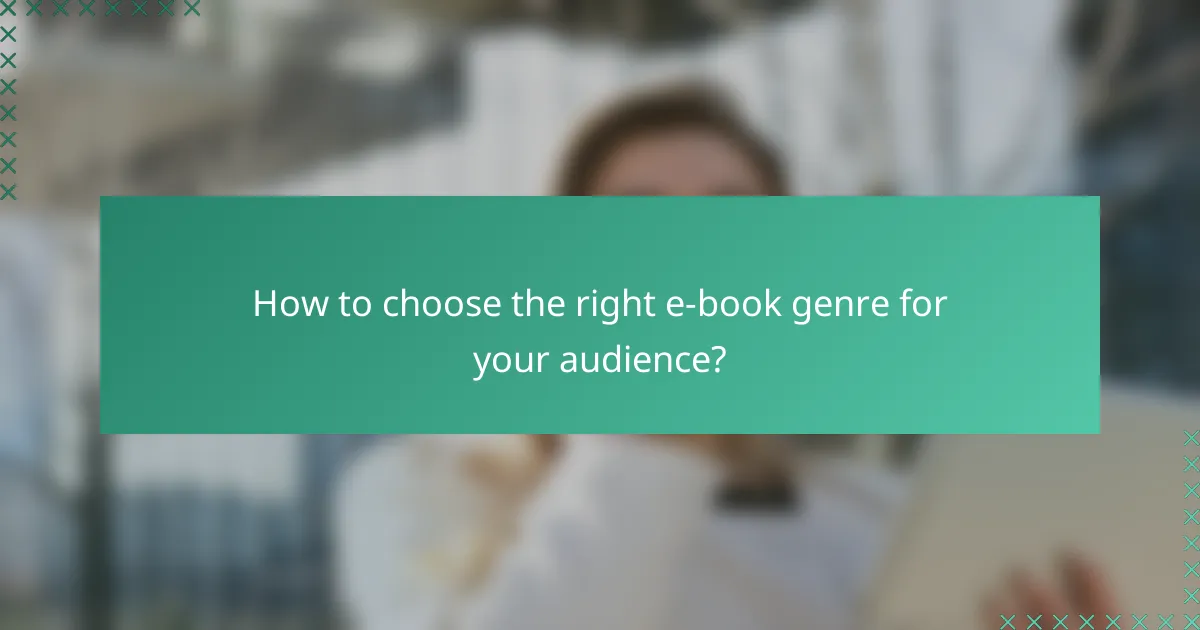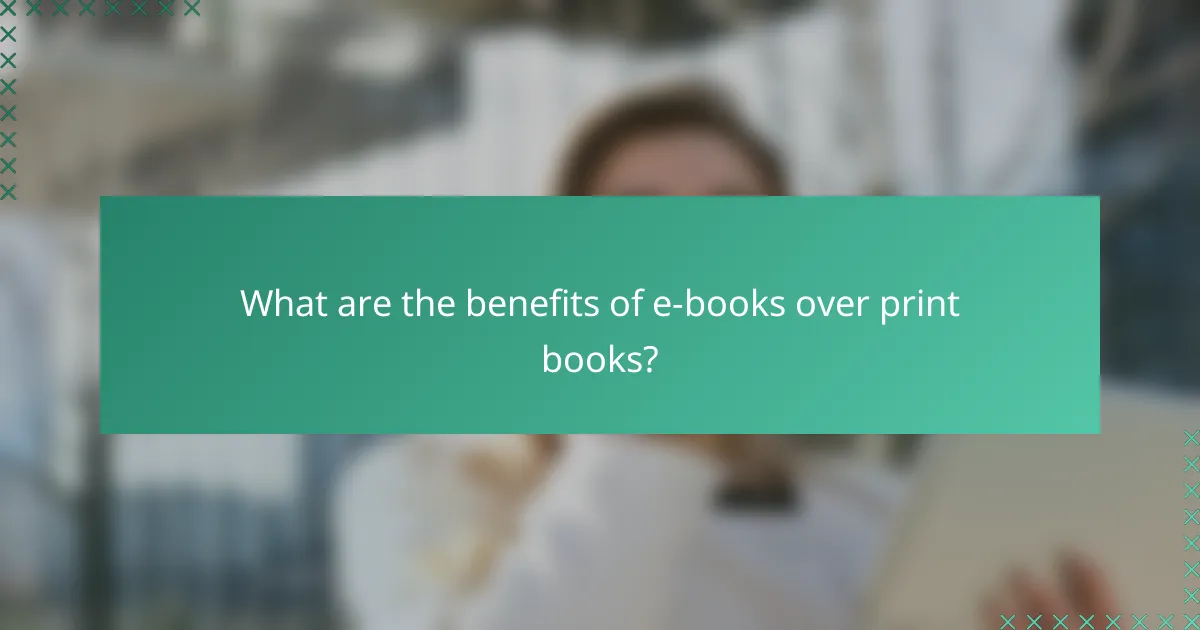E-books have gained immense popularity across various genres, such as fiction, non-fiction, self-help, romance, and science fiction, each appealing to distinct audiences. Understanding the diverse preferences of these readers is crucial for authors and publishers to effectively tailor their content and marketing strategies. Additionally, e-books are available in multiple formats, including PDF, EPUB, MOBI, and KF8, ensuring compatibility with a wide range of devices and enhancing the reading experience.

What are the popular e-book genres in the UK?
In the UK, popular e-book genres include fiction, non-fiction, self-help, romance, and science fiction. Each genre attracts distinct audiences and offers unique reading experiences, making them widely sought after in digital formats.
Fiction
Fiction e-books encompass a wide range of sub-genres, including literary fiction, thrillers, and historical novels. Readers often gravitate towards compelling narratives and character-driven stories, which are readily available in e-book format.
Popular authors like Ian McEwan and Zadie Smith have significant followings, and their works are frequently featured in e-book collections. Fiction e-books are typically priced competitively, often between £2.99 and £9.99, making them accessible to a broad audience.
Non-fiction
Non-fiction e-books cover topics such as history, politics, biographies, and self-improvement. This genre appeals to readers seeking knowledge and insights into real-world issues or personal development.
Many non-fiction titles are available as e-books, often priced similarly to fiction, with many falling in the £3.99 to £12.99 range. Readers appreciate the convenience of accessing factual information on-the-go, making e-books a popular choice for this genre.
Self-help
Self-help e-books focus on personal development, mental health, and lifestyle improvement. This genre has gained immense popularity as readers look for guidance on various life challenges.
Titles like “The Subtle Art of Not Giving a F*ck” and “Atomic Habits” are examples of best-sellers in this category. Self-help e-books typically range from £4.99 to £14.99, providing readers with affordable resources for personal growth.
Romance
Romance e-books are a leading genre, featuring sub-genres such as contemporary, historical, and paranormal romance. This genre attracts a diverse audience, with many readers enjoying the escapism and emotional connections found in these stories.
Popular authors like Jojo Moyes and Sophie Kinsella have a strong presence in the e-book market, with prices generally ranging from £2.99 to £8.99. The accessibility of romance e-books allows readers to indulge in their favorite stories anytime, anywhere.
Science Fiction
Science fiction e-books explore futuristic concepts, advanced technology, and speculative scenarios. This genre appeals to readers who enjoy imaginative storytelling and thought-provoking themes.
Notable authors like Arthur C. Clarke and Philip K. Dick have influenced the genre significantly, and their works are widely available as e-books. Prices for science fiction e-books typically range from £3.99 to £10.99, making them an attractive option for fans of speculative fiction.

Who is the target audience for e-books?
The target audience for e-books includes a diverse range of readers, each with unique preferences and needs. Understanding these groups can help authors and publishers tailor their content and marketing strategies effectively.
Young adults
Young adults are a significant audience for e-books, often seeking genres like fantasy, romance, and science fiction. This demographic values accessibility and convenience, making e-books an attractive option for reading on-the-go.
Many young adults prefer interactive features, such as hyperlinks and multimedia elements, which enhance their reading experience. Authors targeting this group should consider incorporating engaging visuals and social sharing options.
Professionals
Professionals often turn to e-books for career development and industry insights, favoring non-fiction genres such as business, self-help, and technology. They appreciate the ability to quickly reference information and highlight key points for future review.
To appeal to this audience, e-books should be concise and well-organized, with clear takeaways. Including actionable tips and case studies can further enhance their value for busy professionals.
Students
Students are a primary audience for e-books, utilizing them for academic purposes across various subjects. E-books provide easy access to textbooks and supplementary materials, often at a lower cost than traditional print versions.
When creating e-books for students, it’s essential to include features like search functionality and note-taking capabilities. Offering study guides or quizzes can also help reinforce learning and engagement.
Parents
Parents often seek e-books for both personal enjoyment and educational content for their children. They may look for parenting guides, children’s literature, and educational resources that can be easily accessed and shared.
To effectively reach this audience, e-books should offer practical advice and relatable stories. Including tips for balancing parenting with personal interests can resonate well with busy parents looking for support and inspiration.

What formats are available for e-books?
E-books are available in several formats, each catering to different devices and user preferences. The most common formats include PDF, EPUB, MOBI, and KF8, each offering unique features and compatibility considerations.
PDF (Portable Document Format) is widely used for e-books due to its ability to preserve formatting across devices. This format is ideal for documents that require a fixed layout, such as textbooks and manuals.
However, PDFs can be less flexible on smaller screens, as they do not adapt to different screen sizes. Readers may find zooming and scrolling cumbersome, especially on mobile devices.
EPUB
EPUB (Electronic Publication) is a popular e-book format that allows for reflowable content, meaning text adjusts to fit various screen sizes. This feature makes EPUB suitable for novels and other text-heavy works.
EPUB files can include multimedia elements and interactive features, enhancing the reading experience. Most e-readers, except Amazon Kindle, support this format, making it versatile for distribution.
MOBI
MOBI (Mobipocket) is primarily used by Amazon Kindle devices. This format supports reflowable text and is optimized for e-reader functionality, making it a good choice for Kindle users.
While MOBI files can include some interactive features, they are generally less flexible than EPUB. Authors and publishers targeting Kindle users should consider this format for compatibility.
KF8
KF8 (Kindle Format 8) is an advanced format used by Amazon for newer Kindle devices. It supports more complex layouts and features than MOBI, including HTML5 and CSS3 capabilities.
KF8 is ideal for e-books that require rich formatting, such as graphic novels or textbooks. However, it is not backward compatible with older Kindle devices, so authors must consider their audience’s device preferences when choosing this format.

How to choose the right e-book genre for your audience?
Choosing the right e-book genre for your audience involves understanding their interests and preferences. This ensures that your content resonates with readers and meets their expectations.
Identify reader preferences
Start by gathering insights into what your target audience enjoys reading. Surveys, social media polls, and feedback from previous publications can provide valuable information about their favorite genres.
Consider demographics such as age, gender, and location, as these factors can influence genre preferences. For example, younger audiences may lean towards fantasy and science fiction, while older readers might prefer historical fiction or non-fiction.
Analyze market trends
Stay informed about current market trends to understand which genres are gaining popularity. Platforms like Amazon and Goodreads often showcase bestsellers and trending categories, providing a snapshot of reader interests.
Additionally, pay attention to seasonal trends and events that may influence reading habits. For instance, romance novels typically see a spike in sales around Valentine’s Day, while thrillers may be more popular during the fall. This knowledge can help you align your e-book genre with market demand.

What are the benefits of e-books over print books?
E-books offer several advantages over print books, including convenience, accessibility, and cost-effectiveness. They can be easily downloaded, stored, and accessed on various devices, making them a practical choice for many readers.
Convenience and Portability
E-books are highly portable, allowing readers to carry an entire library in a single device. This is particularly beneficial for travelers or those with limited space. With e-books, there’s no need to worry about weight or bulk, as they can be accessed on smartphones, tablets, or e-readers.
Additionally, e-books can be read in various lighting conditions, with adjustable font sizes and background colors. This customization enhances the reading experience, accommodating different preferences and needs.
Cost-Effectiveness
E-books are often more affordable than their print counterparts, with many titles available at discounted prices or even for free. This makes them an attractive option for budget-conscious readers.
Moreover, e-books eliminate printing and shipping costs, which can significantly lower the price. Readers can also find numerous promotional deals and subscription services that provide access to a wide range of titles for a flat fee.
Accessibility Features
E-books come equipped with various accessibility features that cater to readers with disabilities. Options such as text-to-speech, adjustable text size, and background color changes make reading easier for individuals with visual impairments.
Many e-readers also support audiobooks, allowing users to switch between reading and listening seamlessly. This flexibility enhances the overall reading experience and ensures that literature is accessible to a broader audience.
